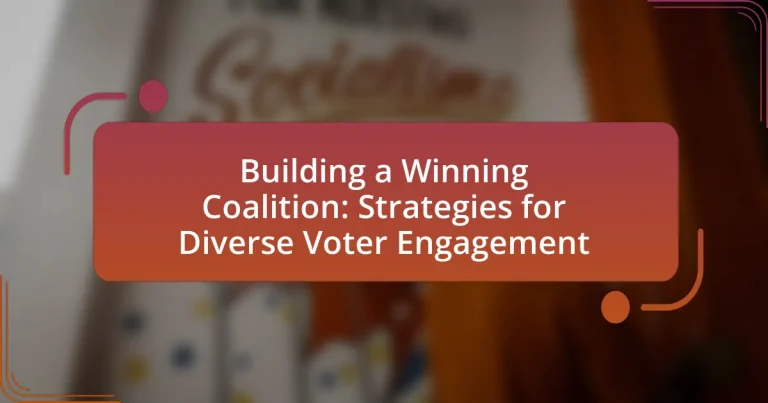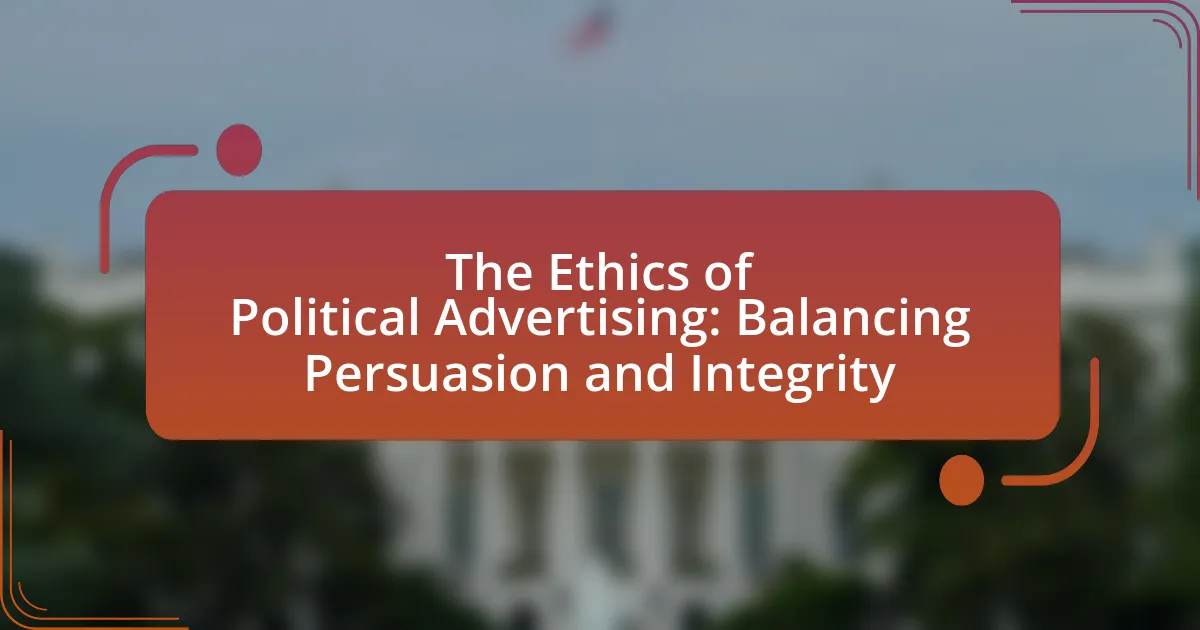The article focuses on building a winning coalition for diverse voter engagement, emphasizing the importance of creating collaborative alliances among various demographic groups to enhance electoral participation. It outlines strategies for understanding voter demographics, addressing cultural influences, and engaging diverse communities to ensure comprehensive representation in the democratic process. Key factors such as age, race, gender, and socioeconomic status are discussed, along with the role of grassroots organizing and effective communication in mobilizing support. The article also highlights potential challenges in coalition building and offers practical tips for fostering inclusivity and effective outreach to diverse voter populations.
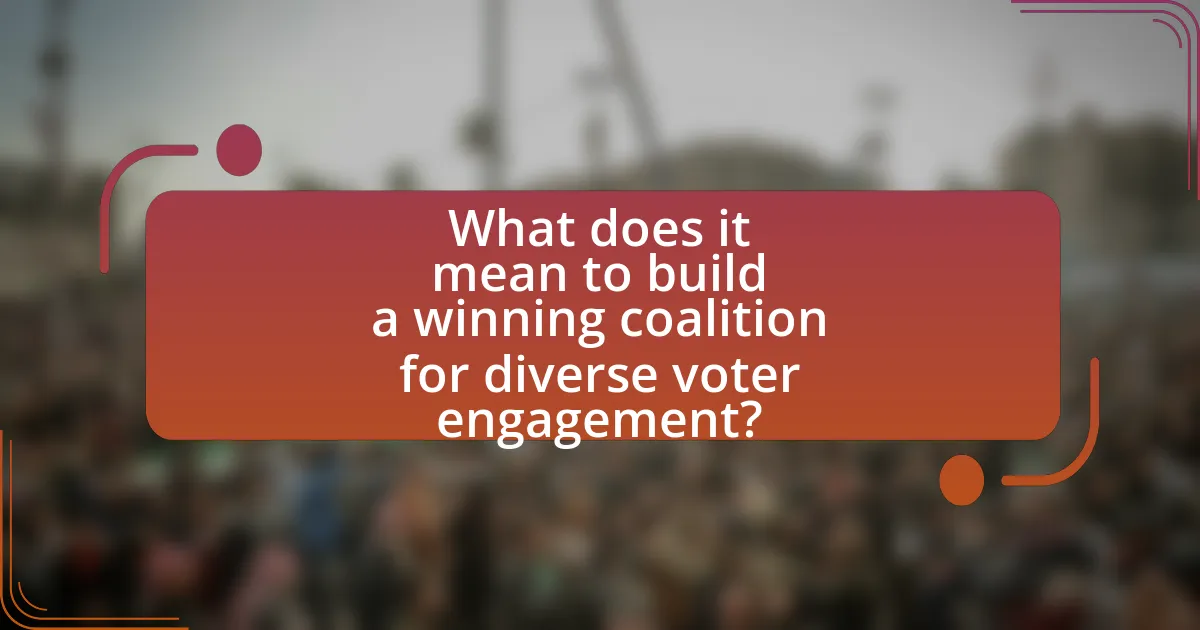
What does it mean to build a winning coalition for diverse voter engagement?
Building a winning coalition for diverse voter engagement means creating a collaborative alliance among various groups to effectively mobilize and represent a broad spectrum of voters. This coalition involves identifying and uniting stakeholders from different racial, ethnic, and socioeconomic backgrounds to ensure that their unique perspectives and needs are addressed in the electoral process.
Successful coalitions leverage shared goals, such as increasing voter turnout and advocating for policies that benefit all members, thereby enhancing the democratic process. Research indicates that diverse coalitions can significantly increase voter participation; for instance, the 2020 U.S. elections saw a record turnout among minority groups, attributed in part to effective coalition-building efforts by organizations focused on voter engagement.
How can understanding the demographics of voters enhance coalition building?
Understanding the demographics of voters enhances coalition building by allowing political groups to identify shared interests and values among diverse populations. By analyzing demographic data such as age, ethnicity, income, and education levels, organizations can tailor their messages and strategies to resonate with specific voter segments. For instance, research from the Pew Research Center indicates that younger voters prioritize climate change, while older voters may focus on healthcare. This knowledge enables coalition builders to create targeted outreach efforts that address the unique concerns of each demographic, fostering unity and collaboration among varied groups. Consequently, effective coalition building relies on a nuanced understanding of voter demographics to align goals and mobilize support effectively.
What key demographic factors should be considered in voter engagement?
Key demographic factors to consider in voter engagement include age, race, gender, socioeconomic status, and education level. Age influences voting behavior, as younger voters tend to have different priorities compared to older generations; for instance, in the 2020 U.S. presidential election, 50% of eligible voters aged 18-29 participated, compared to 71% of those aged 65 and older. Race and ethnicity affect political preferences and turnout rates, with diverse communities often facing unique barriers to engagement. Gender also plays a role, as women have increasingly participated in elections, with 57% voting in 2020 compared to 53% of men. Socioeconomic status impacts access to resources and information, while education level correlates with voter turnout, as those with higher education are more likely to vote. Understanding these factors allows for tailored strategies that effectively engage different demographic groups in the electoral process.
How do cultural backgrounds influence voter preferences and behaviors?
Cultural backgrounds significantly influence voter preferences and behaviors by shaping individuals’ values, beliefs, and priorities. For instance, voters from collectivist cultures may prioritize community welfare and social justice, leading them to support candidates who advocate for policies that promote these values. Research indicates that cultural identity affects political engagement; a study by the Pew Research Center found that Hispanic voters are more likely to support immigration reform, reflecting their cultural ties and experiences. Additionally, cultural narratives and historical contexts can create distinct voting patterns, as seen in the African American community’s strong support for Democratic candidates, rooted in historical struggles for civil rights. These factors illustrate how cultural backgrounds directly impact electoral choices and political participation.
Why is it important to engage diverse voter groups?
Engaging diverse voter groups is crucial for ensuring that all voices are represented in the democratic process. This engagement fosters inclusivity, which leads to more comprehensive policy-making that addresses the needs of various communities. For instance, research by the Pew Research Center indicates that diverse voter participation can significantly influence election outcomes and policy priorities, as seen in the 2020 U.S. presidential election where increased turnout among minority groups played a pivotal role in shaping the results. Therefore, engaging diverse voter groups not only enhances representation but also strengthens the overall health of democracy by promoting equity and social justice.
What are the potential benefits of a diverse coalition in elections?
A diverse coalition in elections enhances representation and broadens appeal to various voter demographics. This inclusivity allows for a more comprehensive understanding of community needs and concerns, leading to policies that resonate with a wider audience. Research indicates that diverse coalitions can increase voter turnout; for instance, a study by the Pew Research Center found that diverse candidate slates can mobilize underrepresented groups, resulting in higher electoral participation. Additionally, diverse coalitions foster innovative solutions by integrating different perspectives, which can improve decision-making and policy effectiveness.
How does diversity in voter engagement impact policy outcomes?
Diversity in voter engagement significantly influences policy outcomes by ensuring that a broader range of perspectives and needs are represented in the political process. When various demographic groups, including different races, ethnicities, genders, and socioeconomic statuses, actively participate in elections, policymakers are more likely to address issues that affect these diverse populations. For instance, research from the American Political Science Review indicates that increased voter turnout among minority groups leads to more inclusive policies, such as those related to healthcare, education, and social justice. This correlation demonstrates that when diverse voices are heard, the resulting policies tend to reflect a wider array of interests and concerns, ultimately leading to more equitable governance.
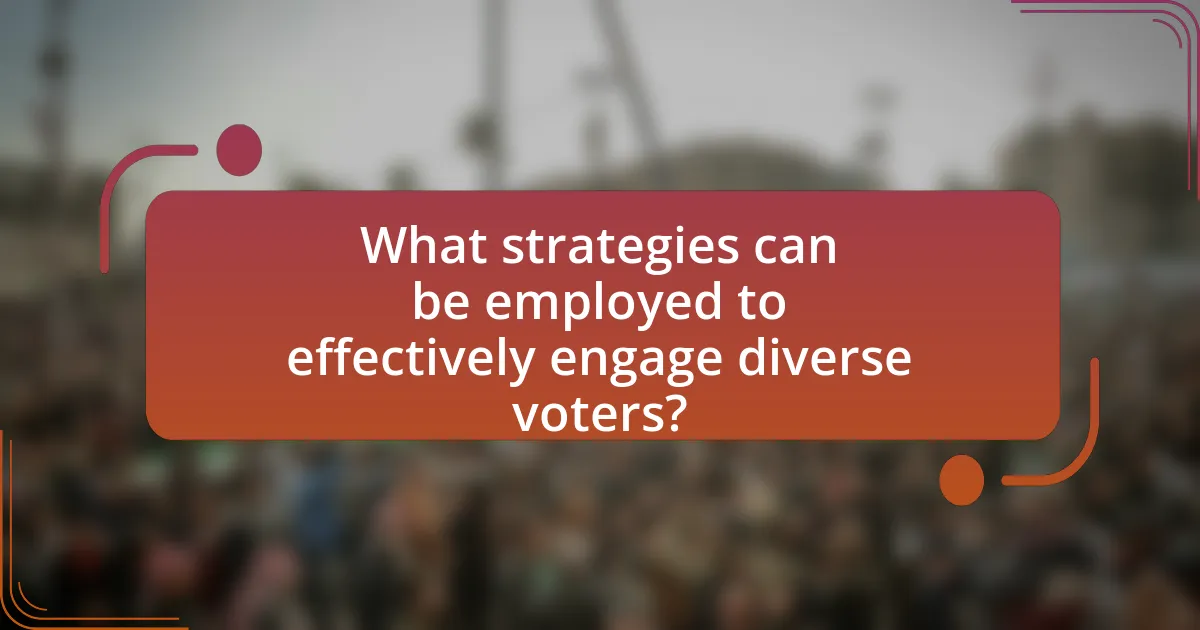
What strategies can be employed to effectively engage diverse voters?
To effectively engage diverse voters, targeted outreach strategies must be employed, including culturally relevant messaging, community partnerships, and inclusive events. Culturally relevant messaging ensures that communication resonates with various demographic groups, reflecting their values and concerns. Community partnerships with local organizations can enhance trust and facilitate access to underrepresented populations. Inclusive events that celebrate cultural diversity can foster a sense of belonging and encourage participation in the electoral process. Research indicates that campaigns utilizing these strategies see increased voter turnout among diverse groups, as evidenced by the 2020 U.S. elections, where targeted outreach led to record participation rates among minority voters.
How can grassroots organizing play a role in coalition building?
Grassroots organizing is essential in coalition building as it mobilizes community members around shared goals, fostering collaboration among diverse groups. This approach empowers individuals to voice their concerns and needs, creating a foundation for collective action. For instance, grassroots movements have historically united various demographics, such as the Civil Rights Movement, which brought together African Americans, labor unions, and religious organizations to advocate for social justice. By leveraging local networks and relationships, grassroots organizing enhances trust and solidarity, making coalitions more effective in addressing complex social issues.
What are the best practices for grassroots outreach to diverse communities?
The best practices for grassroots outreach to diverse communities include building authentic relationships, utilizing culturally relevant messaging, and engaging community leaders. Establishing trust through consistent engagement fosters a sense of belonging and encourages participation. Culturally relevant messaging ensures that outreach resonates with the values and experiences of the community, increasing the likelihood of engagement. Collaborating with community leaders leverages their influence and networks, facilitating broader outreach and deeper connections. Research indicates that organizations employing these strategies see higher participation rates in community initiatives, demonstrating their effectiveness in engaging diverse populations.
How can local leaders be mobilized to support voter engagement efforts?
Local leaders can be mobilized to support voter engagement efforts by establishing clear communication channels and providing them with the necessary resources and training. Engaging local leaders through workshops and informational sessions can enhance their understanding of the importance of voter participation, as evidenced by studies showing that informed leaders are more effective in rallying their communities. Additionally, creating partnerships with local organizations can amplify outreach efforts, as demonstrated by initiatives where local leaders successfully increased voter turnout by collaborating with grassroots movements.
What role does communication play in engaging diverse voters?
Communication plays a crucial role in engaging diverse voters by facilitating understanding and connection among different demographic groups. Effective communication strategies, such as using culturally relevant messaging and multilingual outreach, help to address the unique concerns and values of various communities. For instance, research from the Pew Research Center indicates that tailored communication can significantly increase voter turnout among minority groups, as it fosters a sense of inclusion and representation. By actively listening to diverse voter needs and adapting messages accordingly, campaigns can build trust and motivate participation in the electoral process.
How can messaging be tailored to resonate with different voter groups?
Messaging can be tailored to resonate with different voter groups by understanding their unique values, concerns, and demographics. For instance, research shows that targeted messaging that addresses specific issues, such as healthcare for older voters or climate change for younger voters, significantly increases engagement and support. A study by the Pew Research Center indicates that 70% of voters are more likely to support candidates who address their specific concerns. Additionally, utilizing data analytics to segment voter groups allows campaigns to craft personalized messages that reflect the interests and priorities of each demographic, enhancing the effectiveness of outreach efforts.
What channels are most effective for reaching diverse audiences?
Digital platforms, particularly social media and targeted online advertising, are the most effective channels for reaching diverse audiences. Research indicates that 72% of diverse populations engage with social media daily, making platforms like Facebook, Instagram, and Twitter crucial for outreach. Additionally, community-based organizations and local events serve as vital channels, as they foster trust and facilitate direct engagement with specific demographic groups. According to a study by the Pew Research Center, 63% of minority voters reported that they prefer receiving information about political issues through community events and local organizations, highlighting the importance of these channels in voter engagement strategies.
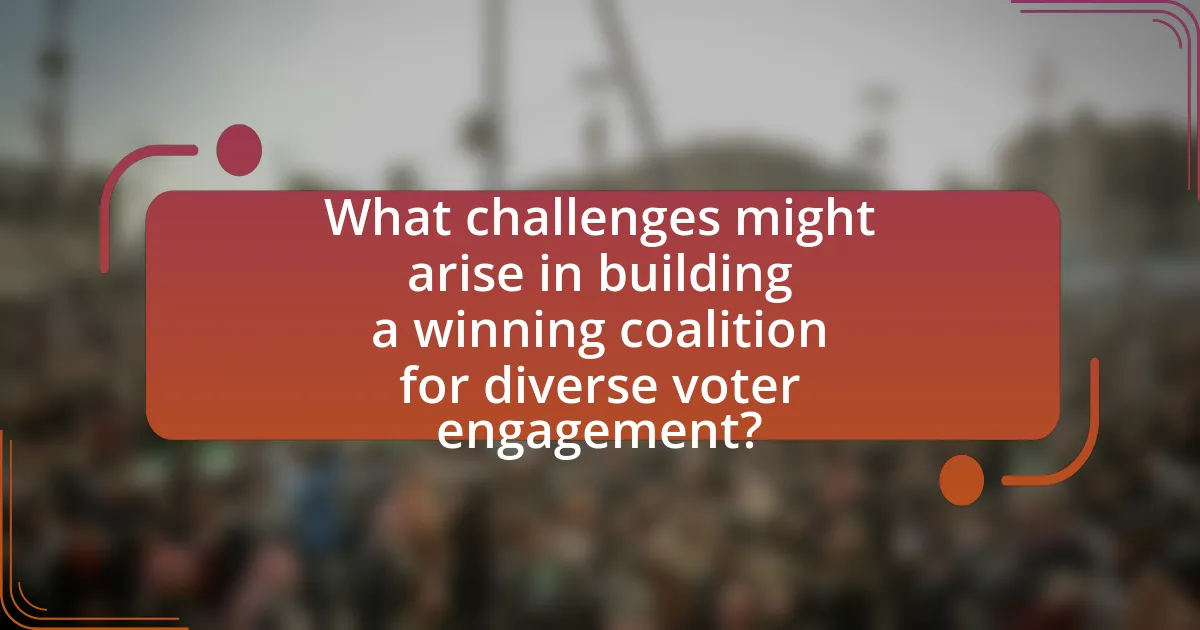
What challenges might arise in building a winning coalition for diverse voter engagement?
Building a winning coalition for diverse voter engagement faces several challenges, including differing priorities among various demographic groups. These groups may have unique needs and concerns, leading to potential conflicts in agenda-setting. For instance, research indicates that minority communities often prioritize issues like immigration reform and social justice, while other groups may focus on economic policies. Additionally, communication barriers can arise due to language differences and cultural misunderstandings, complicating outreach efforts. Furthermore, historical mistrust of political institutions among marginalized communities can hinder participation and engagement. These factors collectively create obstacles in forming a cohesive coalition that effectively represents and mobilizes diverse voter interests.
How can misunderstandings between different voter groups be addressed?
Misunderstandings between different voter groups can be addressed through open dialogue and targeted education initiatives. Facilitating discussions that encourage sharing perspectives helps to clarify misconceptions and build empathy among diverse groups. Research indicates that community forums and workshops can effectively reduce tensions and foster understanding, as evidenced by the success of initiatives like the National Issues Forum, which promotes deliberative dialogue on contentious topics. Additionally, utilizing data-driven outreach strategies that highlight common goals can unify voter groups, as seen in campaigns that successfully engaged diverse demographics by focusing on shared interests rather than divisive issues.
What strategies can be used to foster dialogue among diverse communities?
To foster dialogue among diverse communities, implementing inclusive communication strategies is essential. These strategies include organizing community forums that encourage participation from various cultural backgrounds, utilizing trained facilitators to guide discussions, and promoting active listening techniques to ensure all voices are heard. Research indicates that such approaches can enhance mutual understanding and respect, as evidenced by the National Civic League’s findings, which show that inclusive dialogue initiatives lead to increased civic engagement and collaboration among diverse groups.
How can coalition leaders navigate conflicting interests within the group?
Coalition leaders can navigate conflicting interests within the group by fostering open communication and establishing common goals. By encouraging dialogue among members, leaders can identify shared objectives that align with the diverse interests present. Research indicates that effective communication enhances collaboration and reduces misunderstandings, which is crucial in a coalition setting. For instance, a study by the Harvard Kennedy School highlights that coalitions with clear, shared goals are more successful in achieving their objectives, as they create a sense of unity and purpose among members. This approach not only addresses conflicts but also strengthens the coalition’s overall effectiveness in engaging diverse voter bases.
What are common pitfalls to avoid in coalition building?
Common pitfalls to avoid in coalition building include lack of clear communication, insufficient stakeholder engagement, and failure to establish shared goals. Clear communication is essential; without it, misunderstandings can arise, leading to mistrust among coalition members. Insufficient engagement of all relevant stakeholders can result in a lack of diverse perspectives, which is crucial for a well-rounded coalition. Additionally, failing to establish shared goals can lead to misalignment and conflict, undermining the coalition’s effectiveness. Research indicates that coalitions with clearly defined objectives and inclusive practices are more successful in achieving their aims.
How can overgeneralization of voter needs hinder engagement efforts?
Overgeneralization of voter needs can hinder engagement efforts by failing to address the specific concerns and preferences of diverse voter groups. When organizations assume that all voters within a demographic share the same needs, they risk alienating segments of the population that feel their unique issues are overlooked. For example, a study by the Pew Research Center found that different racial and ethnic groups prioritize different issues, such as healthcare, education, and immigration, indicating that tailored messaging is crucial for effective engagement. Consequently, overgeneralization can lead to ineffective outreach strategies, reduced voter turnout, and a lack of trust in the political process.
What steps can be taken to ensure inclusivity in coalition activities?
To ensure inclusivity in coalition activities, organizations should implement targeted outreach strategies that engage underrepresented communities. This can include conducting surveys to identify the needs and preferences of diverse groups, ensuring that coalition meetings are held in accessible locations, and providing materials in multiple languages. Research indicates that inclusive coalitions are more effective; for instance, a study by the National Democratic Institute found that diverse coalitions can increase voter turnout by up to 20%. By actively involving various stakeholders in decision-making processes and fostering an environment of respect and understanding, coalitions can enhance their effectiveness and reach.
What practical tips can enhance the effectiveness of diverse voter engagement strategies?
To enhance the effectiveness of diverse voter engagement strategies, organizations should prioritize culturally relevant messaging tailored to specific communities. Research indicates that targeted communication increases voter turnout; for example, a study by the Pew Research Center found that personalized outreach can boost engagement by up to 20%. Additionally, leveraging local leaders and influencers to disseminate information fosters trust and credibility, as evidenced by successful campaigns in various demographic groups. Implementing multilingual resources also ensures accessibility, as the U.S. Census Bureau reports that over 21% of the population speaks a language other than English at home, highlighting the need for inclusive communication.
